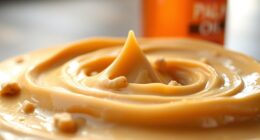I know what you’re thinking – butter? Really? But trust me, once you experience the magic of browned butter, you’ll never look back.
This golden elixir, with its rich and nutty aroma, has the power to transform any dish into a culinary masterpiece.
From sweet treats like cookies and cakes to savory delights like pasta and vegetables, browned butter adds a depth of flavor that is simply irresistible.
So get ready to elevate your cooking game as we explore the wonders of browned butter and its rich nutty appeal.
Key Takeaways
- Browning butter creates the Maillard reaction, resulting in complex flavors and aromas.
- Browning butter enhances the taste of food, adding depth and richness.
- Ghee, made by simmering butter and separating the milk solids, has a similar nutty flavor but a higher smoke point.
- Browning butter is versatile and can be used in both savory and sweet dishes, elevating the taste of various recipes.
The Science Behind Browning Butter
You may be wondering how browning butter actually happens and why it gives such a rich and nutty flavor to your dishes. Well, let me break it down for you.
When you heat butter, its milk solids start to brown, creating a chemical reaction known as the Maillard reaction. This reaction occurs when amino acids and reducing sugars interact at high temperatures, resulting in the development of complex flavors and aromas. As the butter heats up, the milk solids begin to caramelize, releasing a delightful nutty scent that enhances the taste of your food.
Now, you might be thinking, what’s the difference between browning butter and ghee? Well, the main distinction lies in the process.
Browning butter involves heating it until the milk solids turn golden brown, whereas ghee is made by simmering butter until the milk solids separate and are then strained out. While both have a similar nutty flavor, ghee has a higher smoke point and is often preferred in Indian cooking due to its ability to withstand high temperatures without burning.
How to Brown Butter Perfectly Every Time
Achieving the perfect browning of butter every time can be a challenge. However, with a few simple techniques, you can master this culinary art.
First, start by melting the butter in a saucepan over medium heat. As the butter melts, it will begin to foam. Keep a close eye on it, stirring occasionally to prevent any burning. Soon, the foam will subside, and the milk solids at the bottom of the pan will start to turn golden brown. This is the moment you’ve been waiting for – the rich, nutty aroma of browned butter will fill your kitchen.
Once you’ve achieved the perfect browned butter, the possibilities are endless. One of my favorite ways to use it is in sauces. The depth of flavor that browned butter adds to a sauce is unparalleled. Simply drizzle it over steamed vegetables or grilled meats, and you’ll take your dish to a whole new level. You can also use it as a base for pasta sauces, risottos, or even to finish off a creamy soup. The nutty taste of the butter brings a unique and delicious element to any dish.
Enhancing Flavors With Browned Butter
Enhancing flavors in various dishes can be achieved by incorporating the irresistible aroma and taste of perfectly browned butter. When it comes to pasta dishes, browned butter adds a whole new level of depth and richness. Imagine a creamy pasta with a nutty undertone, perfectly complementing the flavors of the sauce and ingredients. Whether it’s a simple spaghetti aglio e olio or a decadent fettuccine Alfredo, the addition of browned butter brings a unique and unforgettable taste.
Not only is browned butter a game-changer for pasta, but it also works wonders in vegetable side dishes. Take roasted Brussels sprouts, for example. Toss them in some browned butter, and they become caramelized and irresistible. The nutty notes of the butter perfectly balance the natural bitterness of the sprouts. You can also drizzle browned butter over steamed asparagus or sautéed green beans for a delightful twist.
Now that we’ve explored how browned butter can elevate savory dishes, let’s move on to sweet treats: desserts with browned butter. Its rich and nutty flavor is a perfect match for desserts like cookies, cakes, and tarts. From browned butter chocolate chip cookies to browned butter pecan pie, the possibilities are endless. Get ready to indulge in the irresistible taste of browned butter in your favorite sweet treats.
Sweet Treats: Desserts With Browned Butter
Now that we’ve covered how to incorporate browned butter into savory dishes, let’s explore the mouthwatering world of desserts that feature this irresistible ingredient.
One of the most decadent ways to use browned butter in desserts is by incorporating it into frostings. The nutty aroma and rich flavor of browned butter adds a depth and complexity that elevates any frosting to new heights. Whether it’s a classic vanilla buttercream or a luscious chocolate ganache, the addition of browned butter takes it to a whole new level of deliciousness.
But the indulgence doesn’t stop there. Browned butter can also be used to create the creamiest, most luxurious ice cream you’ve ever tasted. By infusing the melted butter with vanilla beans or other flavorings before adding it to the ice cream base, you’ll end up with a frozen treat that is velvety smooth and bursting with a toasty, nutty flavor.
As we’ve seen, browned butter can work its magic in both sweet and savory dishes. But now, let’s move on to the savory delights: entrees with browned butter.
Savory Delights: Entrees With Browned Butter
To create a mouthwatering entree, you can try incorporating that irresistible ingredient into your favorite savory dishes. Browned butter adds a rich, nutty flavor that elevates any dish to new heights. Whether you’re making pasta or sauces, here are some creative ways to incorporate browned butter into your recipes:
-
Pasta: Toss your cooked pasta in a pan with browned butter, grated Parmesan cheese, and a sprinkle of black pepper. The browned butter adds a depth of flavor that perfectly complements the pasta’s deliciously chewy texture.
-
Sauces: Use browned butter as a base for your sauces. Start by browning the butter until it turns a beautiful golden color and emits a heavenly aroma. Then, whisk in some flour to create a roux and gradually add your choice of liquids, such as broth or cream. The result is a velvety smooth sauce that will make your taste buds dance with delight.
-
Roasted Vegetables: Drizzle browned butter over your roasted vegetables for an extra burst of flavor. The butter’s nutty notes will complement the natural sweetness of the vegetables, creating a truly delicious side dish.
-
Grilled Meats: Brush browned butter onto your grilled meats for a rich and flavorful finish. The butter will melt into the meat, adding moisture and enhancing the overall taste.
-
Stir-Fries: Instead of using regular oil, try stir-frying your favorite vegetables and protein in browned butter. The butter’s nutty flavor will infuse the dish, making it a standout meal.
Incorporating browned butter into your savory dishes is a surefire way to take your cooking to the next level. Its rich, nutty appeal adds depth and complexity to any dish, making it an ingredient worth experimenting with. So go ahead, get creative, and let browned butter work its magic in your kitchen.
The Versatility of Browned Butter in Baking
Baking becomes a delightful experience when you discover the versatility of incorporating browned butter into your recipes. Not only does it add a rich and nutty flavor, but it also brings a beautiful golden color to your baked goods.
One way to make the most of this delectable ingredient is by using it in flavorful spreads. Imagine slathering a warm slice of toast with a homemade spread made from browned butter, honey, and a hint of cinnamon. The buttery richness combined with the sweetness of honey creates a heavenly combination that will elevate your breakfast to new heights.
Speaking of breakfast, incorporating browned butter into your morning recipes will take your breakfast delights to a whole new level. Whether you’re making pancakes, waffles, or muffins, swapping regular butter for browned butter will add a depth of flavor that will leave you craving for more.
Picture biting into a fluffy pancake, drizzled with maple syrup, and topped with a dollop of browned butter. The caramelized notes from the browned butter will enhance the sweetness of the syrup and create a symphony of flavors in your mouth.
Elevating Everyday Dishes With Browned Butter
You’ll be amazed at how incorporating browned butter can enhance the flavor of your everyday dishes. From simple pasta dishes to creamy sauces, browning butter adds a rich and nutty appeal that takes your meals to a whole new level. Here are some ways you can elevate your cooking with browned butter:
-
Pasta Perfection: Tossing freshly cooked pasta with a generous drizzle of browned butter creates a deliciously decadent base. The nutty aroma and flavor of the butter pair perfectly with any pasta, whether it’s a classic spaghetti or a creamy fettuccine Alfredo.
-
Savory Sauces: Browned butter can be a secret weapon in creating mouthwatering sauces. Whether you’re making a velvety béchamel or a savory brown butter sage sauce, the depth of flavor from browning the butter adds complexity and richness.
-
Vegetable Magic: Transform your everyday vegetables into something extraordinary by sautéing them in browned butter. The butter coats each vegetable, enhancing their natural sweetness and bringing out their flavors in a way that will have you reaching for seconds.
-
Roasted Delights: Drizzle browned butter over roasted meats or vegetables to add a touch of indulgence. The caramelized notes of the butter complement the savory flavors, creating a deliciously satisfying dish.
-
Sweet Treats: Don’t limit browned butter to savory dishes; it can work wonders in desserts too. Incorporate it into cookies, cakes, or even frosting for a nutty twist that will have everyone asking for your secret ingredient.
Frequently Asked Questions
Can I Use Margarine Instead of Butter to Brown?
Sure, you can certainly use margarine instead of butter to brown. Margarine is a common substitute for butter in cooking and can still give you a rich and nutty flavor when browned. Just keep in mind that margarine has a higher water content than butter, so it may take a bit longer to brown.
But overall, it’s a great alternative for those who prefer or need to avoid dairy products.
How Long Can I Store Browned Butter?
Storing browned butter is essential to extend its shelf life and enjoy its rich nutty flavor for longer.
To keep it fresh, I recommend transferring it to an airtight container and storing it in the refrigerator. This will help preserve its taste and prevent it from going rancid.
However, it’s important to note that browned butter can be stored for up to a month in the fridge, but its flavor may gradually diminish over time.
Can I Use Any Type of Pan to Brown Butter?
I can use any type of pan to brown butter, but some pans work better than others. Nonstick pans are convenient because the butter won’t stick to the surface. However, for a richer, nuttier flavor, I prefer using a stainless steel or cast iron pan. These pans conduct heat more evenly, allowing the butter to brown more evenly as well.
It’s important to keep a close eye on the butter while browning, as it can quickly go from golden to burnt.
What Are Some Alternative Uses for Browned Butter?
There are so many incredible ways to use browned butter in both sweet and savory dishes. It’s like a flavor explosion in your mouth!
From drizzling it over roasted vegetables to adding it to a batch of chocolate chip cookies, the possibilities are endless.
I love getting creative in the kitchen and finding new ways to incorporate browned butter in my baking. Trust me, once you try it, you’ll be hooked on its rich, nutty appeal!
Can I Brown Butter in the Microwave?
Yes, you can brown butter in the microwave, but it’s important to follow some safety precautions.
First, use a microwave-safe container and microwave the butter in short intervals, stirring in between, to prevent overheating. Keep a close eye on it to avoid any potential hazards.
However, if you’re looking for alternative ways to brown butter, I recommend using a stovetop method or the oven, as they provide more control and result in a richer, nuttier flavor.
Conclusion
After delving into the world of browned butter and discovering its rich, nutty appeal, I am convinced that this culinary gem is the key to unlocking a world of flavor.
It’s like a golden treasure, adding depth and complexity to both sweet treats and savory delights.
With its versatility in baking and its ability to elevate everyday dishes, browned butter truly is a secret weapon in the kitchen.
So go forth, my friends, and let the magic of browned butter transform your cooking into a masterpiece that will leave your taste buds dancing with delight.



